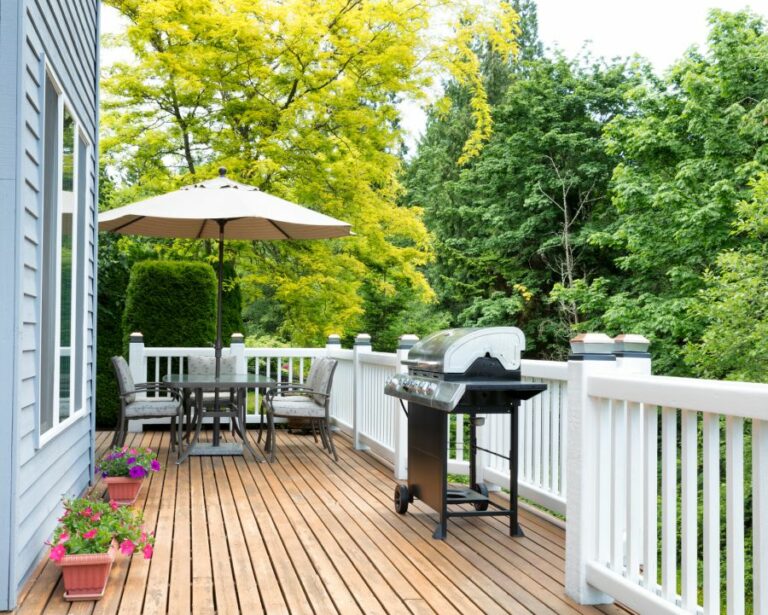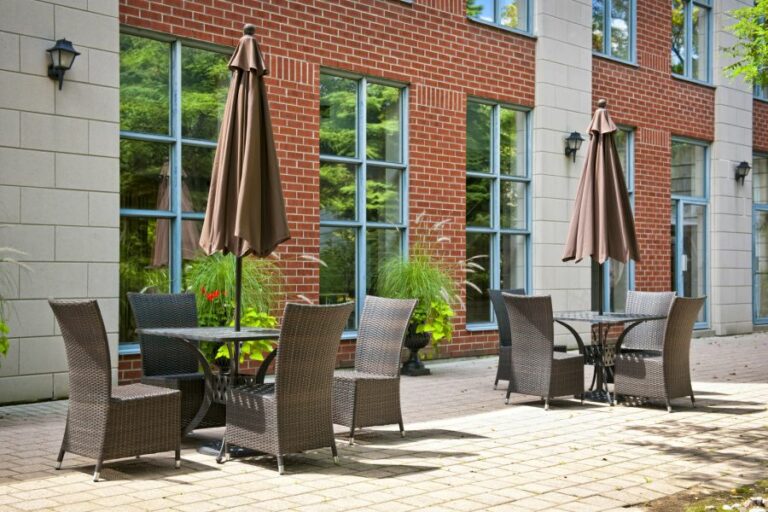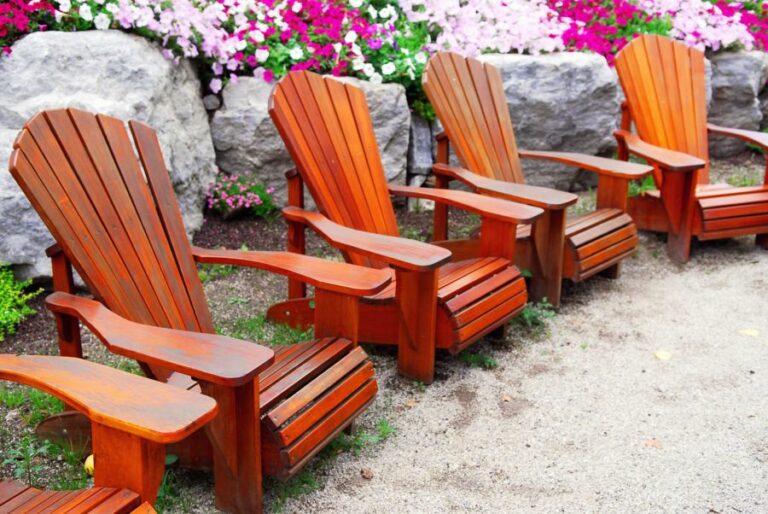Best Paint For Outdoor Wood Steps, 25 Things You Should Know
Are you struggling to find the perfect paint for your outdoor wooden steps? A long-lasting, non-slip option that also enhances your home’s curb appeal? Fret no longer. Our detailed guide explores the best paint options for outdoor wooden steps, comparing durability, finish, and weather resistance to help you make an informed decision.
Best paint for outdoor wood steps:
This article discusses the best paint options for outdoor wooden staircases, recommending water-based acrylic, oil-based alkyd, and deck and porch paint for their respective durability, weather resistance, and finish. Factors to consider when choosing paint include durability, finish, application process, and cleanup. Proper preparation, primer, temperature, weather, and dry time are also important for a successful and long-lasting paint job on outdoor wood steps.

Discover the ideal paint to withstand harsh outdoor elements and protect your wooden steps. We’ve analyzed durability, longevity, and finish quality to provide you with the top recommendations. Read on to give your steps a refreshed, fortified appearance.
Contents
- 1 Top-Quality Paint Options for Outdoor Wooden Staircases
- 2 Which Type of Paint is Best for Outdoor Wooden Staircases?
- 3 Which Type of Paint is Suitable for Outdoor Staircases?
- 4 What is the Optimal Type of Paint for Wooden Front Stairs?
- 5 What is the Optimal Paint Choice for Exterior Wooden Surfaces?
Top-Quality Paint Options for Outdoor Wooden Staircases
Outdoor wood steps, whether leading up to your front door or out to the backyard deck, need protection from the elements to maintain their longevity and visual appeal.
• Top Choices for Outdoor Wood Steps Paint
– Water-Based Acrylic
I highly recommend water-based acrylic paint for wooden outdoor steps because it is a versatile and durable option that offers excellent protection against various weather conditions. Additionally, it is quick-drying and easy to clean up.
Benefits:
- Durable and long-lasting
- Resistant to cracking and peeling
- Fade-resistant
- Quick-drying and easy cleanup
– Oil-Based Alkyd
Oil-based alkyd paint is another excellent option for outdoor wood steps. It is well known for its durability and providing an excellent finish on wooden surfaces.
Benefits:
- Hard and durable finish
- High resistance to weather conditions
- Rich, long-lasting colors
– Deck and Porch Paint
Deck and porch paint is specifically designed to withstand foot traffic and weathering on horizontal surfaces like outdoor steps. These paints often come in a variety of colors and finishes, such as matte, semi-gloss, or gloss.
Benefits:
- Enhanced durability for high-traffic areas
- Skid-resistant options available
- Fade and mildew resistant
• Factors to Consider When Choosing Paint for Outdoor Wood Steps
– Durability
Outdoor wooden steps go through constant wear and tear because of foot traffic and exposure to different weather conditions. Therefore, durability should be a primary factor when choosing the best paint.
– Finish
The finish of your outdoor wood steps is essential for appearance and safety. A glossy or semi-gloss finish offers a visually appealing look and resistance against water and dirt. However, a matte finish or a paint with added texture can provide better slip resistance.
– Application Process
Consider the ease of application when selecting the best paint for your outdoor steps. Some paints may require multiple coats for the desired appearance and protection, while others may be a one-coat solution.
– Cleanup
Consider the paint’s cleanup process, as some types require more effort than others. For instance, oil-based paint may necessitate the use of paint thinner for cleaning brushes and equipment, while water-based paint is easy to clean up with soap and water.
• Tips for Painting Outdoor Wood Steps
– Proper Preparation
Before applying the paint, ensure that the steps are thoroughly cleaned and all loose paint, dirt, and debris are removed. If needed, use a wood filler to fill gaps, knots, or cracks in the wood, sand the surfaces smoothly, and then clean thoroughly.
– Primer
Using a primer before painting outdoor wooden steps is highly recommended, as it helps the paint adhere better, offers additional protection, and results in an even, smooth finish. Make sure to use an exterior primer specifically designed for wooden surfaces.
– Temperature and Weather
When painting outdoor steps, it is vital to consider the temperature and weather conditions, as these factors can significantly impact the drying and curing process. Ideally, paint during moderate weather conditions, when it is not too hot or too cold, without high humidity or rainfall.
– Application Method – Brush, Roller, or Sprayer
The application method can determine the final appearance and quality of the paint job. Depending on the paint chosen, a brush, roller, or sprayer can be used for application.
In general, brushes offer precision and control, while rollers cover a bigger area quickly, and sprayers provide an even coat without brush or roller marks.
– Dry Time
Following the paint manufacturer’s recommended drying time is crucial for a durable, long-lasting finish. It is essential to allow the paint to dry completely between coats and to give the final coat enough time to cure before allowing foot traffic on the steps.
• Final Thoughts
In summary, the best paint for outdoor wood steps would ideally be durable, long-lasting, easy to apply, and visually appealing. Among the top choices are water-based acrylic, oil-based alkyd, and deck and porch paint.
Consider factors such as durability, finish, application process, and cleanup when making your decision. Following the proper preparation, application, and drying guidelines will ensure your outdoor steps look beautiful and withstand the test of time.
Brand | Product Name | Features |
|---|---|---|
Behr | DeckOver | Slip-resistant, durable, water-repellent, suitable for various surfaces, conceal splinters and cracks. |
KILZ | Over Armor | Slip-resistant, smooth and textured finish options, suitable for various surfaces, hides imperfections, resists peeling. |
Rust-Oleum | Porch & Floor | Durable, UV resistant, wear-resistant, weather-resistant, suitable for various surfaces. |
Benjamin Moore | Aura Exterior | Durable, fade resistant, mildew resistant, suitable for various surfaces, self-priming. |
Valspar | Porch & Floor | Slip-resistant, weather-resistant, durable finish, suitable for various surfaces, high-gloss finish for easy cleaning. |
Which Type of Paint is Best for Outdoor Wooden Staircases?
When it comes to maintaining and improving the appearance of your outdoor wooden stairs, selecting the right paint is essential. There are various factors to consider when choosing the right type of paint for your stairs, including durability, slip resistance, and protection against weather and other external factors.
• Assessing Your Wooden Stairs’ Needs
Before diving into selecting the right paint, it’s important first to assess the needs and condition of your wooden stairs. Consider the following factors:
- Degree of wear and tear
- Exposure to elements
- Potential slip hazards
- Wood type and treatment history
These considerations will help you determine the necessary qualities to look for in your chosen paint.
• Types of Paints for Wooden Stairs
Several types of paint are suitable for outdoor wooden stairs, each with advantages and drawbacks.
– Acrylic Latex Paint
Acrylic latex paint is water-based and offers excellent durability, weather resistance, and easy application. Its low odor and low VOC (volatile organic compounds) content make it popular for outdoor wooden stairs.
Furthermore, acrylic latex paint is available in a variety of colors and finishes, including flat, semi-gloss, and gloss, allowing you to choose the appropriate finish for your stairs’ design and purpose.
Recommendation: Acrylic latex paint is an ideal choice for its durability, weather resistance, and versatility in design options.
– Oil-Based Paint
Oil-based paint is a durable and long-lasting option for outdoor wooden stairs. Compared to acrylic latex paint, it takes longer to dry, which can be a disadvantage if you’re in a hurry to complete your painting project.
However, it provides superior adhesion and resistance against wear and tear, making it a favorite among professional painters.
Recommendation: Oil-based paint is recommended for its longevity and durability; however, be prepared for a longer drying time.
– Deck and Porch Paint
Deck and porch paint is specifically designed for outdoor surfaces exposed to foot traffic and harsh weather conditions. These paints are highly durable and weather-resistant, often incorporating additives to increase slip resistance, making them a great option for wooden stairs.
They are typically available in various colors and finishes, including textured or smooth, so you can find one that matches your aesthetic preferences.
Recommendation: Deck and porch paint is a good option for its slip-resistant and weather-resistant qualities, making it suitable for outdoor wooden stairs.
• Important Features to Consider
When selecting the right paint for your outdoor wooden stairs, there are several essential features to keep in mind:
– Durability
Outdoor wooden stairs are exposed to all weather conditions, so choosing a paint that can withstand frequent exposure to rain, snow, sun, and varying temperatures is crucial. Acrylic latex paint, oil-based paint, and deck/porch paint all offer long-lasting durability to withstand the elements.
– Slip Resistance
Safety should always be a priority when painting wooden stairs. Consider adding a slip-resistant additive to your paint or choosing a paint specifically formulated to be slip-resistant, such as deck and porch paint.
This will reduce the risk of accidents caused by slippery steps, especially during wet or icy weather conditions.
– UV Resistance
Prolonged exposure to sunlight can cause the paint on your wooden stairs to fade or lose its color. To avoid this, look for paints with UV-resistant properties, typically found in high-quality acrylic latex and oil-based paints.
– Ease of Application
Finally, the ease of application should also be considered when selecting your paint. Acrylic latex paint is known for its easy application and cleanup, while oil-based paint may require more effort, including the use of a primer and longer drying times.
• Prepping Your Wooden Stairs for Painting
Before painting your stairs, ensure they are properly prepared to achieve the best results. Here are some essential steps in prepping your wooden stairs before painting:
- Clean the stairs thoroughly, removing any dirt, dust, leaves, or debris.
- Sand any rough or splintered surfaces, starting with coarse sandpaper and working your way to finer grits.
- Repair any damaged or loose boards or steps.
- Apply a good-quality wood primer to ensure even paint coverage and adhesion.
Following these steps’ll ensure the best possible outcome for your painting project and a beautiful, long-lasting finish for your outdoor wooden stairs.
• Conclusion
Choosing the right paint for your outdoor wooden stairs can be overwhelming with so many options available. By considering your stairs’ specific needs and utilizing the recommendations provided, you can confidently select the best paint for your project.
Remember, durability, slip resistance, and weather protection should be top priorities for outdoor wooden stairs. Whichever paint you choose, proper preparation and application will ensure a successful and long-lasting result.
Which Type of Paint is Suitable for Outdoor Staircases?
Outdoor steps are exposed to the elements; therefore, they require extra attention when choosing the right type of paint. With so many options on the market, it can be a daunting task to find the perfect paint that looks good and stands up to the wear and tear of daily use.
• Types of Paint Suitable for Outdoor Steps
These are the most common types of paint that work well with outdoor steps due to their durability, weather resistance, and non-slip properties:
– Acrylic-latex paint
Acrylic-latex paint is a versatile, water-based paint that offers good adhesion and flexibility, making it ideal for outdoor steps. It dries quickly, is easy to clean up, and resists peeling, cracking, and fading. Moreover, acrylic-latex paint withstands harsh weather conditions, resisting moisture and UV rays.
If you’re concerned about safety, consider looking for a formula designed specifically for exterior stairs and walkways, as these paints offer additional slip resistance.
– Oil-based paint
Oil-based paint is another popular option for outdoor steps due to its durability and water resistance. However, it tends to take longer to dry than acrylic-latex paint and can be more challenging to clean up, as it requires mineral spirits or paint thinner.
Oil-based paint is known for its good adhesion, making it suitable for high-traffic areas like steps.
– Epoxy paint
Epoxy paint is a two-component paint consisting of resin and a hardener. When mixed together, they create a tough, durable, and slip-resistant coating that adheres well to a variety of surfaces, including concrete, wood, and metal.
Epoxy paint is known for its excellent resistance to chemicals, abrasions, and heavy traffic, making it suitable for outdoor steps. However, it can be a bit more challenging to apply than other types of paint due to its thick consistency and limited working time.
• Preparing the Surface for Painting
Proper surface preparation is essential for achieving a long-lasting and professional-looking result. Below are the steps that need to be followed before painting outdoor steps:
– Cleaning
By sweeping or vacuuming the surface, ensure the steps are free from dirt, dust, and debris. If there are any oil or grease stains, remove them using a suitable cleaner or degreaser. For stubborn stains, a pressure washer may be used.
– Sanding and Repairing
If the steps are made of wood, sand any rough spots, splinters, or peeling paint with sandpaper or a power sander. For concrete steps, patch any cracks or holes with a concrete-repair compound, following the manufacturer’s instructions.
– Priming
Apply a high-quality primer to the steps, ensuring even coverage. This will improve paint adherence and enhance the durability of the paint job. If you’re using an oil-based paint, use an oil-based primer; if you’re using an acrylic-latex paint, use a water-based primer.
Allow the primer to dry according to the manufacturer’s instructions before proceeding to paint.
• Applying the Paint
Follow these steps to achieve a professional and long-lasting result while painting your outdoor steps:
– Choosing the Right Tools
To apply paint efficiently and evenly, use a high-quality paintbrush or roller designed for your chosen paint type. For acrylic-latex paint, synthetic-bristle brushes or rollers are recommended; for oil-based paint, choose brushes with natural bristles or rollers with a natural-fiber cover.
– Applying Multiple Coats
For the best result, apply at least two coats of paint, allowing the first coat to dry completely before applying the second one. This will create a more durable and even finish that can last for years with minimal maintenance.
– Adding a Non-Slip Additive
To ensure the safety of your steps, consider mixing a nonslip additive into the paint before applying it to the surface. This will create a textured surface that offers better traction, helping to prevent slips and falls.
• Maintenance and Upkeep
To keep your newly painted steps looking great and prolong their lifespan, perform regular maintenance such as sweeping and cleaning to remove dirt and debris. Inspect the steps for signs of wear and promptly address any issues to prevent them from worsening. With proper care, your outdoor steps can maintain their appearance and functionality for many years to come.
In conclusion, choosing the right paint for your outdoor steps involves taking into consideration factors such as durability, weather resistance, and safety.
By selecting an appropriate paint type, properly preparing the surface, and following the recommended application techniques, you can achieve a high-quality finish that looks great and stands up to the demands of daily use.
What is the Optimal Type of Paint for Wooden Front Stairs?
Wooden front steps can be a welcoming and charming addition to a home, but they are also exposed to the elements and are in constant use by foot traffic. Consequently, they require a durable and protective paint finish to maintain their appearance and structural integrity.
• Importance of Choosing the Right Paint
Selecting the appropriate paint for wooden front steps is crucial for various reasons:
- Durability: The right paint provides a protective layer against water, sun, and general wear and tear, extending the life of the wooden steps.
- Coverage: Good-quality paint will have superior coverage, requiring fewer coats and, ultimately, less time and effort in the painting process.
- Ease of Application: Better paint products often have smoother application properties, making the job more manageable for both professionals and DIYers.
- Aesthetics: The appearance of your front steps is essential for curb appeal. The right paint finish can enhance the beauty of the wood grain and create an attractive, welcoming entry to your home.
• Types of Paint for Wooden Front Steps
Three primary types of paint suitable for wooden front steps are water-based (acrylic), oil-based, and deck-specific. Each type has its advantages and disadvantages, which we will discuss in further detail.
– Water-Based (Acrylic) Paint
When it comes to quick-drying and easy-to-apply options, acrylic paint is a popular choice for wooden front steps. It has several advantages:
- Quick-drying: Water-based paint dries considerably faster than oil-based counterparts, allowing for multiple coats in a short time frame.
- Water cleanup: Cleanup is simple, requiring only soap and water.
- Low VOCs: Acrylic paint emits fewer volatile organic compounds (VOCs), making it a more environmentally friendly option.
One drawback of acrylic paint is that it generally doesn’t offer the same level of durability as oil-based paint. However, using a high-quality exterior-grade acrylic paint specifically designed for wood will significantly increase its durability on wooden front steps.
– Oil-Based Paint
For more durability, oil-based paint is often preferred for wooden front steps. Benefits include:
- Durability: Oil-based paint typically creates a harder, more durable finish than acrylic paint, providing better protection against the elements and foot traffic.
- Smooth finish: This type of paint tends to dry with a smoother finish, which can improve the appearance of the steps.
The main downside to oil-based paint is that it can be more challenging to work with, given its longer drying time, more potent odors, and the need for specialized cleanup products. Moreover, oil-based paint may be more susceptible to yellowing over time, particularly when exposed to direct sunlight.
– Deck-Specific Paint
As the name suggests, deck-specific paint is formulated specifically for deck surfaces, making it an excellent option for wooden front steps.
These paints often combine the best qualities of both water-based and oil-based paints, offering excellent durability, resistance to wear, and ease of application. Deck paints can be either water-based or oil-based.
Several specialized deck paints on the market cater specifically to high-traffic areas, providing extra protection against scuffing and scratching from foot traffic. Many also include UV protection to guard against fading and degradation from sunlight.
• Recommendations for the Best Paint for Wooden Front Steps
Based on our analysis of the above paint types, here is what we recommend:
- Choose a deck-specific paint if you’re looking for optimal durability and the added protection necessary for wooden front steps. Opt for water-based deck paint if you prioritize a lower VOC level and ease of cleanup.
- For a balance between durability and ease of application, go for a high-quality exterior-grade acrylic paint designed specifically for wood. Ensure it has adequate protection against weathering and UV damage to prevent premature wear.
- Oil-based paint is a solid choice for those who value a long-lasting, smooth finish for their wooden front steps. However, be prepared to deal with longer drying times and more difficult cleanup.
Ultimately, the best paint for your wooden front steps will depend on your specific needs and preferences. Consider durability, ease of application, and aesthetic appearance when making your decision.
And always remember to prep the surface properly, use a suitable primer if necessary, and apply the paint according to the manufacturer’s guidelines to ensure lasting, beautiful results for your wooden front steps.
What is the Optimal Paint Choice for Exterior Wooden Surfaces?
Outdoor wood furniture and structures, such as decks, fences, and pergolas, require the right type of paint to protect against the elements and maintain their appearance.
• Factors to Consider When Choosing Paint for Outdoor Wood
– Durability
When exposed to harsh weather conditions, outdoor wood needs paint that can withstand constant exposure to rain, sun, wind, and temperature fluctuations. Long-lasting paint will save you time and money on maintenance and repainting.
– UV Resistance
The sun’s ultraviolet (UV) rays can cause the paint’s color to fade over time. Choosing paint with high UV resistance is essential to ensure it retains its color for an extended period.
– Moisture Resistance
Moisture can cause wood to rot and lead to mold and mildew growth. Ensure the paint you choose effectively resists moisture to prolong the life of your wooden structures.
– Flexibility
Outdoor wood expands and contracts as temperatures change. A flexible paint can adapt to these changes without cracking or peeling.
– Ease of Application and Cleanup
Some paints can be more challenging to apply than others. Consider your skill level and how much time you can devote to the painting project when choosing the paint. Furthermore, the ease of cleanup is essential when dealing with paint, as some paints require special solvents for removal.
• Types of Paint for Outdoor Wood
Based on the factors discussed, here are the main types of paint suitable for outdoor wood.
– Latex (Acrylic) Paint
Latex or acrylic paint is a water-based paint that dries quickly and is less prone to cracking or peeling due to its flexible nature. It provides excellent long-lasting protection and is resistant to yellowing, fading, and blistering.
Latex paint is easy to apply and clean up with soap and water, making it a popular choice for many homeowners.
Recommended Product: Behr Premium Plus Exterior Paint & Primer
This 100% acrylic paint offers excellent protection against the elements, resists fading and cracking, and is easy to apply. The built-in primer simplifies the painting process and provides added durability.
– Oil-Based (Alkyd) Paint
Oil-based or alkyd paint tends to have higher durability and moisture resistance compared to water-based paints. It is known for creating a smoother finish that resists chipping and peeling.
However, oil-based paints are more challenging to apply and require solvents for cleanup, making them less environmentally friendly.
Recommended Product: Rust-Oleum Protective Enamel
This oil-based paint provides excellent durability, rust prevention, and moisture resistance. It is suitable for wood as well as metal surfaces, making it a versatile choice for outdoor painting projects.
– Solid Stain
Solid stains are similar to paint in providing a layer of protection and adding color to wood surfaces. They offer a more natural wood look and provide some UV and moisture resistance.
Recommended Product: Behr Premium Solid Color Waterproofing Wood Stain & Sealer
This 100% acrylic solid stain offers excellent adhesion, UV resistance, and protection against water and moisture. The paint-like finish makes it a suitable alternative to traditional paint.
– Semi-Transparent Stain
Semi-transparent stains provide a balance between the more vibrant color of solid stains and the natural wood look. They offer moderate UV and moisture resistance.
Recommended Product: Olympic Elite Advanced Stain + Sealant
This semi-transparent stain provides enhanced UV protection and water repellency. It also contains mildew-resistant properties, making it an excellent choice for outdoor wood surfaces exposed to wet conditions.
• Preparation and Tips for a Successful Paint Job
After selecting the best paint for your outdoor wood, proper preparation and application techniques are critical for a long-lasting and visually appealing paint job.
- Clean the surface: Remove dirt, mold, and mildew from the wood surface with a cleaner specifically designed for exterior wood. Rinse thoroughly and allow the wood to dry.
- Sand: Sand the surface to remove any old paint or stain and create a smooth, even surface for the new paint to adhere to.
- Prime: Apply a suitable exterior wood primer before painting, especially for bare wood or surfaces with previous paint issues.
- Follow manufacturer’s instructions: Some paints may have specific requirements for application, drying times, or the number of coats needed. Ensure you read and follow these instructions carefully.
• Conclusion
Selecting the best paint for outdoor wood depends on factors such as durability, UV resistance, moisture resistance, and ease of application. Whether you choose latex or acrylic paint, oil-based paint, or a stain, the crucial aspect is preparing the wood surface correctly and following the manufacturer’s instructions.
Investing in high-quality paint and proper application techniques will ensure your outdoor wood surfaces remain protected and are visually appealing for years to come.
Paint Type | Benefits |
|---|---|
Latex Paint | Easy to apply, fast-drying, can expand and contract with wood, resists mildew, and has low odor. |
Acrylic Latex Paint | High-quality paint with excellent adhesion, UV resistance, and superior durability. Ideal for high-traffic areas. |
Oil-Based Paint | Excellent durability and adhesion, can smoothly cover wood knots, and is resistant to wear and abrasion. |
Exterior Wood Stain | Enhances the natural beauty of wood, water-resistant and provides protection against UV rays. Available in various finishes. |
Paint & Primer In One | Saves time and effort by combining the steps of primer and paint. Offers good adhesion, coverage, and durability. |







